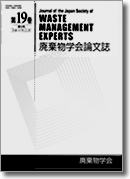All issues

Volume 12 (2001)
- Issue 6 Pages 241-
- Issue 5 Pages 191-
- Issue 4 Pages 143-
- Issue 3 Pages 93-
- Issue 2 Pages 49-
- Issue 1 Pages 1-
Volume 12, Issue 6
Displaying 1-4 of 4 articles from this issue
- |<
- <
- 1
- >
- >|
Paper
-
Ayako Tachifuji, Yasushi Matsufuji, Masataka Hanashima2001Volume 12Issue 6 Pages 241-248
Published: November 30, 2001
Released on J-STAGE: May 31, 2010
JOURNAL FREE ACCESSRecently, global warming is becoming a serious problem. But there is little research on the generation of greenhouse gases from landfill, especially regarding nitrous oxide. So, we carried out experiments using landfill modeled lysimeters and shaking tests to clarify the production of nitrous oxide. The results of this research are summarized as follows ;
1) In landfill mainly disposed of incineration residue, nitrous oxide is produced by biological oxidation of ammonium (nitrification), biological denitrification and chemical reduction of nitrate.
2) Nitrification and denitrification take place in the same waste layer.View full abstractDownload PDF (5691K) -
Hidehiro Kaneko, Minoru Iida, Kimiaki Hirayama2001Volume 12Issue 6 Pages 249-255
Published: November 30, 2001
Released on J-STAGE: May 31, 2010
JOURNAL FREE ACCESSThe mechanisms behind the composting reaction are not fully understood in spite of its popularity as a organic solid waste treatment method. For example, it is understood that carbon in the decomposed organic substrate may convert into either gaseous carbon dioxide or solid carbon such as bacterial cells in the aerobic composting reaction. However their quantitative relationships have not been well clarified.
This paper tried to clarify the qualitative relationship between the amount of substrates decomposed and solids produced by using soluble substrates instead of general solid compost materials. The effect of incubation temperature and C/N ratio of material were also investigated. The results showed that higher temperature and higher C/N ratio were advantageous in reducing the amount of material at an earlier stage.View full abstractDownload PDF (2345K) -
Masahiro Osako, Masato Yamada, Yuzo Inoue, Yong-Jin Kim, Joung-Ku Park ...2001Volume 12Issue 6 Pages 256-265
Published: November 30, 2001
Released on J-STAGE: May 31, 2010
JOURNAL FREE ACCESSIn Korea there are serious problems as it is impossible to landfill municipal solid waste incineration bottom ash (MSWIBA) because the leaching concentration of lead (Pb) from MSWIBA frequently does not meet the regulatory limit. This study was conducted not only in order to find out the factors which make the leaching concentration of Pb high and propose measures to make the landfilling of MSWIBA possible in Korea but also in order to investigate whether the same phenomena associated with Pb high concentration leaching have been taking place in Japan.
Samples were taken from MSWIBA piled at an outside stock yard of Korean MSWI plant. Korean samples and an additional sample taken from a Japanese plant were analyzed to measure elemental contents and leaching concentrations of metals by Japanese Leaching Test No. 13 (JLT-13) and pH dependent leaching test (pH-stat) . Results on the leachability of heavy metals from MSWIBA samples were compared with statistical data based on previous reports. The comparative study suggested that the high leaching concentration of Pb was due to hydroxides generated by dissolution of oxidized alkali and alkali earth metals such as calcium (Ca), sodium (Na) and potassium (K) which are contained at high concentrations in MSWIBA. It is therefore necessary that the aging techniques, including carbonation against heavy metals and neutralization by carbon dioxide in air, be applied prior to landfill to meet the Korean regulatory limit. As phenomenon like this high-concentration leaching of Pb in Korea have taken place in Japan, it is necessary to take appropriate landfill disposal and direct utilization of MSWIBA into consideration from aspects of Pb leaching as soon as possible.View full abstractDownload PDF (1427K) -
Changho Cho, Masahiro Hatsu, Kazuhiro Takamizawa2001Volume 12Issue 6 Pages 266-274
Published: November 30, 2001
Released on J-STAGE: May 31, 2010
JOURNAL FREE ACCESSLignocellulose is abundant in various agricultural wastes. Lignocellulosics can be hydrolyzed to liberate sugars, with emphasis on large-scale production of useful compounds by means of acid or enzymatic hydrolysis. Many agro-industrial wastes contain hemicellulose in relatively high amounts. In nature, hemicellulose is the second most abundant constituent of lignocelluloses. Bioconversion of hemicellulose produces monosaccharides i. e. D-xylose. This xylose thus could be used as a substrate for fermentation to various useful compounds such as butanol and xylitol. The purpose of the present study is the preparation of a database of sugar composition of agricultural wastes and to develop a method for the production of D-xylose for effective utilization of agricultural wastes.
For the hard shell of bean group, it was found by acid hydrolysis that the content of D-xylose was higher than the residue of soft-drink products. 36 g, 18.7 g, 18.3 g, 17.1 g, 12.6 g of D-xylose were contained in 100 g of pistachio shells, walnut shells, sunflower seed peels, barley brans and chestnut shells, respectively and it was found to be very good renewable source of D-xylose. In the case of the enzymatic hydrolysis of raw pistachio shells which were only subjected to milling pretreatment (0.5 mm size), 36g of D-xylose was produced when mixed enzyme solution from Penicilliumsp. AHT-1 andRhizomucor pusilluscontaining 3, 000 and 33 U per g of sample with xylanase and, β-xylosidase activity, respectively. The rate of the enzymatic hydrolysis in this finding was about 100%, compared to acid hydrolysis.View full abstractDownload PDF (1131K)
- |<
- <
- 1
- >
- >|